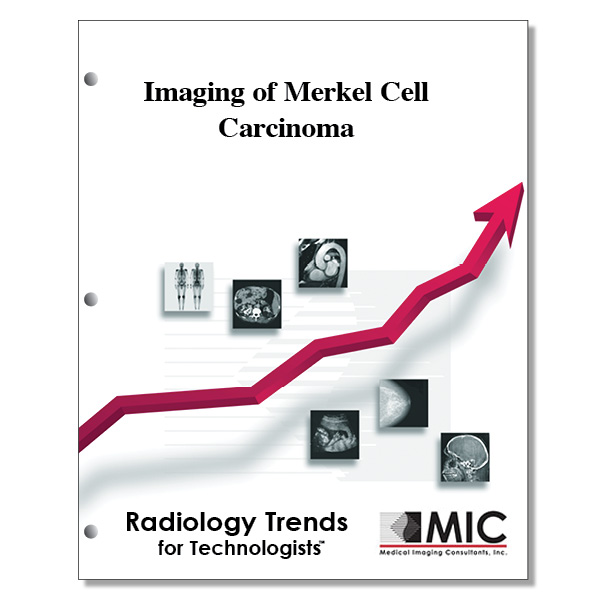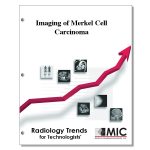

Imaging of Merkel Cell Carcinoma
Imaging findings characteristic of Merkel cell carcinoma are highlighted as well as the significance of CT, MRI, sentinel lymph node mapping, <sup>18</sup>F-FDG PET/CT, and other nuclear medicine studies.
Course ID: Q00623 Category: Radiology Trends for Technologists Modalities: CT, MRI, Nuclear Medicine, PET, Radiation Therapy2.0 |
Satisfaction Guarantee |
$24.00
- Targeted CE
- Outline
- Objectives
Targeted CE per ARRT’s Discipline, Category, and Subcategory classification:
[Note: Discipline-specific Targeted CE credits may be less than the total Category A credits approved for this course.]
Computed Tomography: 1.50
Procedures: 1.50
Head, Spine, and Musculoskeletal: 0.50
Neck and Chest: 0.50
Abdomen and Pelvis: 0.50
Magnetic Resonance Imaging: 1.50
Procedures: 1.50
Neurological: 0.50
Body: 0.50
Musculoskeletal: 0.50
Nuclear Medicine Technology: 2.00
Procedures: 2.00
Endocrine and Oncology Procedures: 1.00
Other Imaging Procedures: 1.00
Registered Radiologist Assistant: 2.00
Procedures: 2.00
Abdominal Section: 0.50
Thoracic Section: 0.50
Musculoskeletal and Endocrine Sections: 0.50
Neurological, Vascular, and Lymphatic Sections: 0.50
Sonography: 1.50
Procedures: 1.50
Superficial Structures and Other Sonographic Procedures: 1.50
Radiation Therapy: 2.00
Patient Care: 0.50
Patient and Medical Record Management: 0.50
Procedures: 1.50
Treatment Sites and Tumors: 1.00
Treatments: 0.50
Outline
- Introduction
- Clinical Features
- Causative Factors
- MCPyV Serology Test
- Staging and Prognosis
- Role of Imaging
- Imaging of Primary or Regional MCC
- Sentinel Lymph Node Biopsy
- Detecting Nodal or Distant Metastasis
- Treatment
- Follow-up or Assessment of Treatment Response
- Role of Specific Nuclear Medicine Studies
- 18F-FDG PET
- Bone Scintigraphy
- Somatostatin Receptor-Seeking Nuclear Medicine
- 18F-FDG PET versus 68Ga-Somatostatin Analog PET
- Peptide Receptor Radionuclide Therapy
- Conclusion
Objectives
Upon completion of this course, students will:
- be familiar with percentage of MCC patients with nodal or distant metastasis at initial presentation
- identify the SSRT types for which MCC has a higher affinity
- recognize the typical clinical feature of MCC nodules
- be familiar with the significant features of MCC
- be familiar with the serology test used for evaluation of MCC patients
- be familiar with the clinical practice guidelines of the NCCN
- be familiar with the stages of the AJCC TNM staging system
- identify the most reliable staging tool for identifying subclinical nodal MCC disease
- be familiar with the estimated 5-year overall survival for MCC patients with local MCC disease
- identify the imaging modality that enables real-time imaging possible with simultaneous fine-needle or core needle biopsy
- be familiar with the reported mean maximum SUV at 18F-FDG PET for primary MCC
- be familiar with the sensitivity of SLNB in Stage I and II MCC
- be familiar with the administration of 99mTc sulfur colloid for sentinel lymph node mapping
- identify the imaging modality used to localize sentinel lymph nodes in anatomically complex areas during lymphoscintigraphy
- recognize the imaging modalities that may be used at MCC metastasis
- identify the imaging modality that is increasingly being used for detection of distant MCC metastasis
- identify which imaging modality should be used for brain metastasis in MCC patients
- be familiar with the standard treatment options for MCC patients
- be familiar with the preferable treatment for MCC patients with distant metastasis
- identify the immunotherapy agents used for systemic therapy of MCC patients
- be familiar with the imaging criteria for MCC patients receiving immunotherapy
- identify the imaging modality that has significantly influenced treatment decisions and management of MCC patients
- identify the radiopharmaceutical used to perform bone scintigraphy in MCC patients
- be familiar with the flare phenomenon in bone scintigraphy
- identify the radiopharmaceuticals that can be linked to peptides that bind to SSTR
- be familiar with the advantages of 68GA-DOTATATE vs. 111In-pentetreotide for imaging patients with NETs
- be familiar with the preparation time for imaging a patient with 68GA-labeled somatostatin
- identify the only PET radiotracer indicated for MCC in the NCCN guidelines
- be familiar with the guidelines for tumor grading based on ENETS
- identify the radioisotopes used for therapeutic treatment of MCC
